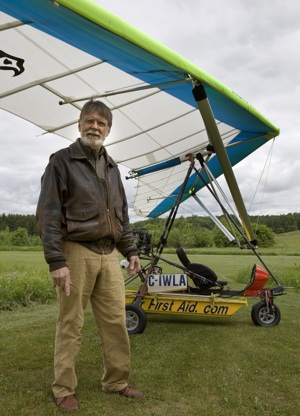
Look to the Skies
By Treena Hein
General aviation Canadian innovatorSpecially-designed ultralight planes equipped for large-scale disaster relief.
Bill Lishman, also know as ‘Father Goose,’ will always be associated with ultralight planes. He rose to prominence in 1988 for guiding birds such as Canada Geese and Whooping Crane by air on safe migration routes – a venture called ‘Operation Migration.’ Now, Lishman is using his passion for the ultralight to turn it into a natural disaster first response vehicle. The idea came in late 1998, when Hurricane Mitch wrecked devastation in Central America.

Bill "Father Goose" Lishman's Rescue Trike ultralight can carry up to 250 lbs. of air-dropped disaster relief cargo.
“Small towns and villages were cut off from road transport and a sufficient number of helicopters to ferry in supplies were not available in the critical period after the storm,” Lishman says. “I began to think about how ultralights could make immediate deliveries of water, food, medical supplies and communications equipment.” The tiny aircraft could also transport the injured, all at a fraction of the cost of existing response systems.
Making the idea a reality (dubbed ‘Air First Aid’) would, however, require an experienced and trained corps of ultralight volunteer pilots, the cooperation of existing disaster relief agencies – and a fleet of specially-designed ultralight aircraft strategically based around the world. According to Lishman, Ultralights are ideal for delivering emergency supplies.
“They’re easily transportable by cargo aircraft, and can be assembled and operational in less than two hours,” he says. “They have excellent short field performance and a steep climbing rate, and most can take off or land in less than sixty metres.”
Certified ultralight aircraft can be purchased for about $50,000 CAD, he notes, and a fleet of 25 or 30 could be therefore purchased for less than a single turbine helicopter such as a Bell Jetranger. One ultralight can carry a pilot, three hours of fuel and 250 lbs. of cargo, while a fleet of fifteen—including pilots and eight tons of emergency supplies—can all safely fit into a standard cargo aircraft.
To equip ultralights for emergency response, Lishman conceptualized a drop mechanism that could be accessed easily by the pilot, while his or her hands are still available to control the aircraft. Engineer Paul Yarnall, owner of New York-based Technical Resolutions consulting firm, made the design a reality.
“Basically, the brake pedal doubles as the release pedal,” Lishman says. When the cargo pod is attached to the aircraft, the selection valve is on brake mode and is locked by the lever that controls the cargo pod release. Prior to the drop, the lever is lifted, turning the selection valve from brake to release position.
To do the drop during a low-level run, the pilot only needs to push the brake pedal at the right moment. “This design means that the pilot has to make two determined actions, which greatly minimizes accidental release,” says Lishman. “After the cargo is released, the valve is automatically turned back to brake mode.”
In 2007, Air First Aid ran a mock disaster scenario with ultralights carrying wireless satellite communications and cameras. “We did several drops on grass of a loaded pod from a height of up to two metres, with no damage to the contents,” Lishman says. Most recently, as another demonstration with his C-IWAL 50 horse power initial prototype, Lishman dropped corn at a local fly in/corn roast from a base about 15 km away. “I was able to deliver 125 lbs. of corn (the volume of the corn precluded a heavier load) every 30 minutes,” he says.
The actual production aircraft (named Rescue Trikes) will have double the horse power, double the load-carrying capacity and a range boosted by fifty percent. The next demonstration will involve these models, perhaps in a real disaster area. Lishman and other Air First Aid organizers are in the middle of negotiating a deal for the production of the Rescue Trike with an established aircraft manufacturer, and concurrently working out overall co-operation details with “one of the world’s largest relief organizations.”
Delivering disaster relief by air has Lishman thinking about other ways to help. He’s developed a prefabricated quickly- deployable emergency shelter that can be turned into a permanent residence using local materials. Right now, he’s testing prototypes made of moulded fiberglass sections that bolt together and exploring the market. “I believe disaster relief can be greatly improved,” he says, “and we’re on the way to making that happen.”
www.airfirstaid.com
www.operationmigration.org
